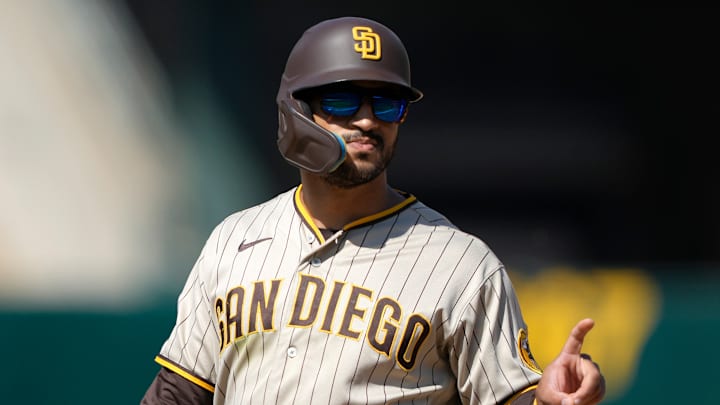When the Yankees finalized their acquisition of Juan Soto from the San Diego Padres last Wednesday night, the trade made instant headlines. The New York Post featured a photoshopped image of Soto in a Yankees uniform on their back cover, and every national outlet from ESPN to The Athletic soon had coverage up about the Yankees newest superstar.
Lost in the shuffle, however, was the other outfielder that San Diego sent to the Bronx in that seven-player deal. Trent Grisham, a former top-100 prospect with two years of team control would also be heading east.
In spite of the shadow cast over him, Grisham should be seen as more than just a throw-in. He's coming off of two consecutive down offensive seasons, but he's just two years removed from being an above average offensive player, and three years removed from being seen as the Padres' center fielder of the future.
Grisham's calling card has always been his elite defense in center field, which, before the Yankees acquired Alex Verdugo from the Red Sox, would have made him a natural fit on the roster while they awaited the return of Jasson Dominguez. Now, with Verdugo expected to start in left field and Soto in right, the Yankees are forced to run Aaron Judge out in center field, relegating Grisham to a bench role despite providing the best defensive upside out of their center field options.
Barring injuries to starters between now and Opening Day, this will be the first time since his rookie year that Grisham will not enter the season as his team's starting center fielder. He played in 59 of 60 games during the shortened 2020 season, 132 during an injury-shortened 2021 campaign, and over 150 in each of the past two years.
The fact that Grisham continued to receive tons of playing time for a competitive Padres team even as he struggled at the plate speaks volumes of what the Padres believed about his true capabilities. Of course, his defense in center field was still valuable to have on a daily basis, but even as he failed to hit, Grisham continued to walk at an impressive clip, setting a career-high walk rate of 13.5% in 2023. That was the 14th-best mark out of qualified batters, and would've been the best out of qualified Yankees by nearly three percentage points.
So if Grisham still has his eye, why isn't he hitting a lot? The simple answer is that he's been making poorer swing decisions. His strikeout rate has jumped from 22.6% in 2021 to 27.7% in 2023, a result of him chasing more pitches outside the strike zone. In Grisham's two best offensive seasons in 2020 and 2021, he chased 16.8% and 18% of pitches, respectively. In 2022 and 2023, he chased 20.7% and 21.6% of pitches.
But what's been encouraging about Grisham's struggles is what he can do when he does make contact with the baseball. In 2023, despite slashing .198/.315/.352, Grisham set career highs in barrel percentage (11.9%), average exit velocity (90.3 MPH), and xwOBACON (.385), which attempts to value the quality of a hitter's contact based on batted ball data. He also put up his best hard-hit rate out of all his full seasons at 40% -- 3.7% better than the league average.
It's a bit harder to determine exactly why more of the balls he's smoking aren't falling for hits. He isn't making a ton of contact in the zone, which sets him back, but based on his much improved quality of contact, some better results should be expected.
One of the best explanations is that he shifted his approach before the 2022 season to become more of a pull hitter, which likely hurt him playing with that deep right-center field at Petco Park. Another explanation is that he hit a lot of grounders in 2022, and got under the ball too much in 2023.
In Yankee Stadium, however, lefties who pull the ball in the air a lot are often rewarded. Just take Anthony Rizzo as a recent example. After making a name for himself early in his career as a spray hitter who could beat the shift, he became much more of a power threat by aiming his bat at the short porch in Yankee Stadium. Grisham could follow in his footsteps.
Whenever that first injury hits the Yankees' outfield depth, Grisham will likely be the guy to step in and fill the void. And with some adjustments to his swing decisions and an offensive environment that's a much better fit for his hitting profile, he should end up being more than just a replacement-level depth piece.
